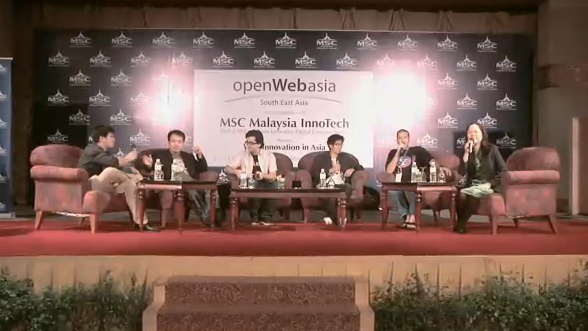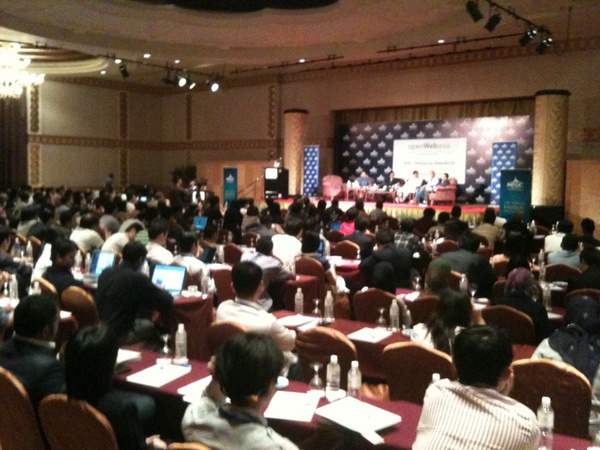 Earlier this month, I attended OpenWebAsia – South East Asia in Kuala Lumpur/Malaysia, a two-day tech and web industry event that attracted over 350 international attendees. The event shined a spotlight on a market that’s still largely overlooked: a whopping 600 million people live in South East Asia, which boasts a rapidly growing web and mobile population.
Earlier this month, I attended OpenWebAsia – South East Asia in Kuala Lumpur/Malaysia, a two-day tech and web industry event that attracted over 350 international attendees. The event shined a spotlight on a market that’s still largely overlooked: a whopping 600 million people live in South East Asia, which boasts a rapidly growing web and mobile population.
What follows is a short summary of just a few presentations, panel discussions, and startup demos I witnessed at OpenWebAsia (those with a focus on Asia only). I will update this article with more material once it becomes available (find the agendas for day one and two here and here).
Growing Digital In Asia – An Overview (panel discussion)
The event kicked off with a panel discussion between Mohan Belani (Co-founder at mobile gaming company Mobret and former Director at startup community e27), Michael F. Smith Jr. (Director of Global Initiatives at Yahoo!), Googler and OpenWebAsia co-founder Chang Kim, and myself.
Moderator Preetam Rai had us cover a lot of ground during the 60 minutes, including how:
- Japan is obsessed with the mobile web (mailing, social networking, mobile gaming etc.)
- Japan’s mobile web is still growing
- Korea is starting to embrace web services from overseas
- Koreans love communicating in groups
- Smartphones conquer Korea, as opposed to Indonesia where feature phones still rule (and take two SIM cards)
- South East Asia is positioned in the global web market
- the region is seeing an explosion in cell phone usage
- most South East Asian startups are locked up in their home markets
- those startups can boost their chances of “going global” (use English, adopt UI/UX, focus on making money etc.)
Please click here to watch a video of the discussion, which is provided by Satoo.tv (embedding didn’t work, sorry).
What’s Happening In China? (presentation)
Shanghai-based entrepreneur and blogger Dr. Gang Lu shared some insights on what’s going on in one of the world’s “hottest” web markets right now, namely China (which now has over 420 million web users and 786 million mobile subscribers).
Lu’s presentation touches upon a range of peculiarities and current trends in China’s web and mobile market. It’s embedded below:
This Week In Asia (panel discussion)
Podcast series This Week In Asia (iTunes link) recorded its 58th episode live on stage at Open Web Asia. Guests included again Michael F. Smith Jr., Dr. Bernhard Leong (co-founder at mobile startup Chlkboard and This Week In Asia producer), Brian Wong (ex-Digg business development manager and founder at mobile ad startup Kiip), Daniel Cerventus (web producer and organizer of the event), and again myself (moderated by Kay Chew Lin).
Topics discussed include:
- India-based mobile ad network Inmobi‘s global landgrab
- mobile web usage in Japan
- Open Web Asia as a very early web industry event in the region
- pitching and delivery as still underdeveloped skills among South East Asian entrepreneurs
 Again, please head over to Satoo.tv for a video of the discussion (but you can also listen to it over at This Week In Asia’s homepage in podcast format).
Again, please head over to Satoo.tv for a video of the discussion (but you can also listen to it over at This Week In Asia’s homepage in podcast format).
Current Challenges In South East Asia’s Tech Scene
It’s still very early in the game, it’s already a huge market, and there’s room for massive future growth in South East Asia’s web and mobile industry. But there are still some significant hurdles to overcome, especially if you regard South East Asia as one region.
Some hurdles I personally see in South East Asia’s web and mobile market (and on the way to a possible integration) are the:
- still relatively undeveloped tech ecosystem and its “chicken and egg” problem
(depending on the country: big number of copycats, relatively low number of startups, few to almost no VCs firms/angel investors, low salaries for engineers, low propensity of skilled employees to work for startups, fewer people with an entrepreneurial mindset etc.) - historically, culturally, and economically diverse markets
- much lower online spend than in North America or Europe
- weak exit environment (IPOs, trade sales)
- political and legal problems in some South East Asian countries
(IP protection, bureaucracy for startups, general political instability) - massive “brain drain”
- still low Internet penetration (examples: Indonesia has 12.5% Internet penetration, Vietnam has 25.7%, the Philippines just 24.5%)
- fragmented mobile landscape
- underdeveloped online and mobile payment infrastructure (if any)
Many of these problems, for example the low Internet penetration, will probably solve themselves in the future. And in fact, local startups, partly financed by local venture capital firms (which do exist), are starting to crop up all over the place.
Selection Of Malaysia-Based Web And Mobile Startups
Here are some startups that are based in Malaysia, mostly in Kuala Lumpur:
- Cravecast, an online music startup (their first product, Cravecharts, is a music streaming service)
- MobileApps.com, which is planned to become a “global cross-platform mobile app store” in fall this year
- Cikgu2U, an e-learning site that allows groups of students to study together online (in Malay)
- Guppers, a mobile business solution provider with offices in Kuala Lumpur and the US
- Offgamers, a game payment solution provider with over 300,000 customers worldwide
- Terato Tech, a mobile startup that develops for iPhone and Android
- LTT Global, which focuses on the mobile learning and edutainment fields
If you want to know more about Malaysia’s web scene, head over to the Entrepreneurs.my blog or follow the Twitter account of Kuala Lumpur-based mover and shaker Daniel Cerventus. For more South East Asia-related information, have a look at the e27 and SGEntrepreneurs blogs or download the This Week In Asia tech podcasts.
Credit for the photo on top: Ben Israel

